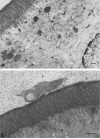Intracellular and interstitial expression of Helicobacter pylori virulence genes in gastric precancerous intestinal metaplasia and adenocarcinoma
- PMID: 12695995
- PMCID: PMC2569196
- DOI: 10.1086/368133
Intracellular and interstitial expression of Helicobacter pylori virulence genes in gastric precancerous intestinal metaplasia and adenocarcinoma
Abstract
Gastric intestinal metaplasia (IM) and gastric cancer are associated with Helicobacter pylori, but the bacterium often is undetectable in these lesions. To unravel this apparent paradox, IM, H. pylori presence, and the expression of H. pylori virulence genes were quantified concurrently using histologic testing, in situ hybridization, and immunohistochemistry. H. pylori was detected inside metaplastic, dysplastic, and neoplastic epithelial cells, and cagA and babA2 expression was colocalized. Importantly, expression of cagA was significantly higher in patients with IM and adenocarcinoma than in control subjects. The preneoplastic "acidic" MUC2 mucin was detected only in the presence of H. pylori, and MUC2 expression was higher in patients with IM, dysplasia, and cancer. These novel findings are compatible with the hypothesis that all stages of gastric carcinogenesis are fostered by persistent intracellular expression of H. pylori virulence genes, especially cagA inside MUC2-producing precancerous gastric cells and pleomorphic cancer cells.
Figures





References
-
- Uemura N, Mukai T, Okamoto S, et al. Effect of Helicobacter pylori eradication on subsequent development of cancer after endoscopic resection of early gastric cancer. Cancer Epidemiol Biomarkers Prev. 1997;6:639–42. - PubMed
-
- Blaser MJ, Perez-Perez GI, Kleanthous H, et al. Infection with Helicobacter pylori strains possessing cagA is associated with an increased risk of developing adenocarcinoma of the stomach. Cancer Res. 1995;55:2111–5. - PubMed
Publication types
MeSH terms
Substances
Grants and funding
LinkOut - more resources
Full Text Sources
Medical
Miscellaneous

